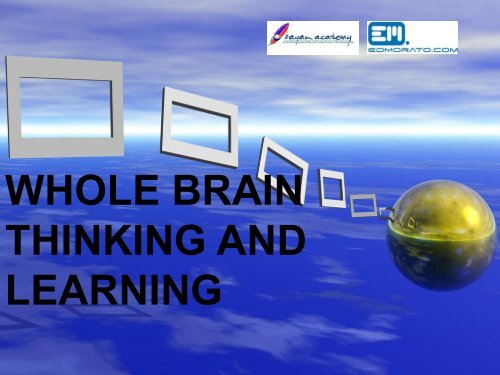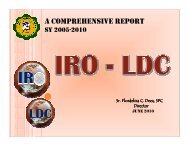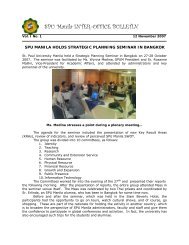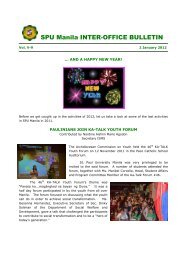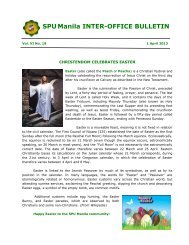WHOLE BRAIN THINKING AND LEARNING
WHOLE BRAIN THINKING AND LEARNING
WHOLE BRAIN THINKING AND LEARNING
You also want an ePaper? Increase the reach of your titles
YUMPU automatically turns print PDFs into web optimized ePapers that Google loves.
<strong>WHOLE</strong> <strong>BRAIN</strong><br />
<strong>THINKING</strong> <strong>AND</strong><br />
<strong>LEARNING</strong>
“The human brain is an enchanted<br />
loom where millions of flashing<br />
shuttles weave a dissolving pattern,<br />
always a meaningful pattern, though<br />
never an abiding one, a shifting<br />
harmony of sub patterns. It is as if<br />
the Milky Way entered upon some<br />
cosmic dance.”<br />
- Sir Charles Sherrington
“In each human brain, there are an estimated<br />
one million, million (1,000,000,000,000) brain<br />
cells. Each brain cell (neuron) contains a vast<br />
electrochemical complex and powerful<br />
microdata processing and transmitting system<br />
that, despite its complexity, would fit on the<br />
head of a pin.”<br />
- Tony Buzan
“I HAVE TWO <strong>BRAIN</strong>S,<br />
THE LEFT <strong>AND</strong> THE RIGHT”
Number skills<br />
Left brain<br />
functions<br />
Written language<br />
Spoken language<br />
Reasoning<br />
Right hand control<br />
Scientific skills
Right brain<br />
functions<br />
3D Forms<br />
Insight<br />
Art awareness<br />
Left hand<br />
control<br />
Imagination<br />
M<br />
u<br />
s<br />
i<br />
c
“I HAVE THREE <strong>BRAIN</strong>S:<br />
REPTILIAN, LIMBIC <strong>AND</strong><br />
NEOCORTEX”
THE TRIUNE <strong>BRAIN</strong> THEORY<br />
By: Dr. Paul Mclean
“I HAVE FOUR <strong>BRAIN</strong>S:<br />
LEFT CEREBRAL, LEFT<br />
LIMBIC, RIGHT LIMBIC,<br />
RIGHT CEREBRAL
The HBDI developed by Hermann yielded<br />
a brain dominance profile<br />
Logical<br />
Factual<br />
Critical<br />
Technical<br />
Analytical<br />
Quantitative<br />
Conservative<br />
Structure<br />
Sequential<br />
Organized<br />
Detailed<br />
Planned<br />
Visual<br />
Holistic<br />
Intuitive<br />
Innovative<br />
Conceptual<br />
Imaginative<br />
Interpersonal<br />
Kinesthetic<br />
Emotional<br />
Spiritual<br />
Sensory<br />
Feeling
PREFERRED SUBJECTS<br />
Arithmetic<br />
Algebra<br />
Calculus<br />
Logic<br />
Science<br />
Technology<br />
Finance<br />
A<br />
D<br />
Arts<br />
Geometry<br />
Design<br />
Poetry<br />
Architecture<br />
Marketing<br />
Programming<br />
Accounting<br />
Technical<br />
Management<br />
Production<br />
B<br />
C<br />
Social Sciences<br />
Psychology<br />
Dance<br />
Drama<br />
High-Skilled Sports<br />
People-Management
PREFERRED PROFESSIONS<br />
Lawyers<br />
Engineers<br />
Computer Systems Analysts<br />
Financial Analysts<br />
Technicians<br />
Physicians<br />
Statisticians<br />
Bureaucrats<br />
Administrators<br />
Bookkeepers<br />
Planners-Programmers<br />
Elementary Teachers<br />
Policemen<br />
Cashiers<br />
Production Supervisors<br />
Maintenance People<br />
Classical Musicians<br />
A<br />
B<br />
Entrepreneurs<br />
Explorers<br />
Artists<br />
Playwrights<br />
Scientists in R&D<br />
Advertising<br />
D Composers<br />
Jazz Musicians<br />
C<br />
Guidance Counselors<br />
Public Relations<br />
Nurses<br />
Social Workers<br />
Entertainers<br />
HRD<br />
Salesmen<br />
Priests
PREFERRED <strong>LEARNING</strong> ACTIVITIES: If you are an A-<br />
quadrant thinker, you prefer to learn and act in this way:<br />
• Collecting data and information<br />
• Organizing information logically in a framework, not to the last detail.<br />
• Listening to informational lectures<br />
• Reading textbooks (most textbooks are written for quadrant A thinkers)<br />
• Studying example problems and solutions<br />
• Thinking through ideas<br />
• Doing library searches<br />
• Doing research using the scientific method<br />
• Making up a hypothesis, then testing it to find out if it is true<br />
• Judging ideas based on facts, criteria, and logical reasoning<br />
• Doing technical case studies<br />
• Doing financial studies<br />
• Dealing with hardware and things, rather than people<br />
• Dealing with reality and the present, rather than with future possibilities<br />
• Traveling to other cultures to study technological artifacts
PREFERRED <strong>LEARNING</strong> ACTIVITIES: If you are an B-<br />
quadrant thinker, you prefer to learn and act in this way:<br />
• Following directions instead of trying to do something in a different way<br />
• Doing repetitive, detailed homework problems<br />
• Testing theories and procedures to find out what is wrong with them<br />
• Doing lab work, step by step<br />
• Writing a sequential report on the results of experiments<br />
• Using programmed learning and tutoring<br />
• Finding practical uses for knowledge learned - theory is not enough<br />
• Planning projects; doing schedules, then executing according to plan<br />
• Listening to detailed lectures<br />
• Taking detailed notes<br />
• Making time management schedules - the schedule is important, not people<br />
• Making up a detailed budget<br />
• Practicing new skills through frequent repetition<br />
• Taking a field trip to learn about organizations and procedures<br />
• Writing a “how-to” manual about a project
PREFERRED <strong>LEARNING</strong> ACTIVITIES: If you are an C-<br />
quadrant thinker, you prefer to learn and act in this way:<br />
• Listening to and sharing ideas<br />
• Motivating yourself by asking “why” - looking for personal meaning<br />
• Experiencing sensory input - moving, feeling, touching, smelling, tasting<br />
• Using group-study opportunities and group discussions<br />
• Keeping a journal to record feelings and spiritual values, not details<br />
• Doing dramatics-the physical acting out is important, not imagination<br />
• Taking people-oriented field trips<br />
• Traveling to other cultures to meet people; hosting a foreign student<br />
• Studying with classical background music; making up rap songs<br />
• Using people-oriented case studies<br />
• Respecting others’ rights and views, people are important, not things<br />
• Learning by teaching others<br />
• Learning by touching, feeling, and using a tool, object, or machinery<br />
• Reading the preface of a book to get clues on the author’s purpose<br />
• Preferring video to audio to make use of body language clues
PREFERRED <strong>LEARNING</strong> ACTIVITIES: If you are an D-<br />
quadrant thinker, you prefer to learn and act in this way:<br />
• Looking for the big picture and context, not the details of a new topic<br />
• Taking the initiative - getting actively involved<br />
• Doing simulations - asking what-if questions<br />
• Making use of the visual aids in lectures<br />
• Doing problems with many possible answers<br />
• Appreciating the beauty in the problem (and in the solution)<br />
• Leading a brainstorming session - wild ideas, not the team, are important<br />
• Experimenting; playing with ideas<br />
• Exploring hidden possibilities<br />
• Thinking about trends<br />
• Thinking about the future<br />
• Relying on intuition, not facts or logic<br />
• Synthesizing ideas and information to come up with something new<br />
• Using future-oriented case discussions<br />
• Trying a different way of doing something just for the fun of it
Cerebral<br />
Left mode<br />
Right mode<br />
Limbic<br />
Engineering<br />
managers
Cerebral<br />
Left mode<br />
Right mode<br />
Limbic<br />
Finance<br />
managers
Cerebral<br />
Left mode<br />
Right mode<br />
Administrators<br />
Limbic
Cerebral<br />
Left mode<br />
Right mode<br />
R & D managers<br />
Limbic
Cerebral<br />
Left mode<br />
Right mode<br />
Limbic<br />
CEO’s<br />
male or female
Cerebral<br />
Left mode<br />
Right mode<br />
Secretaries<br />
Limbic
Cerebral<br />
Left mode<br />
Right mode<br />
Strategic managers<br />
Limbic
Cerebral<br />
Left mode<br />
Right mode<br />
Entrepreneurs<br />
Limbic
Skills and Competencies of the Four Quadrants<br />
Quadrant A<br />
Ability to<br />
Appreciate<br />
Relevant Facts<br />
and Figures<br />
Ability to Do<br />
Logical<br />
Reasoning<br />
- Cause and Effect<br />
Critical Thinking<br />
- Determine<br />
important<br />
variables<br />
among many<br />
that would affect<br />
the outcome the<br />
most<br />
<br />
<br />
Quadrant B<br />
Ability to<br />
Classify,<br />
Categorize<br />
Ability to<br />
Order,<br />
Sequence and<br />
Program<br />
<br />
<br />
Quadrant C<br />
Ability to<br />
Manage Self<br />
Ability to<br />
Manage Other<br />
People<br />
<br />
<br />
<br />
<br />
Quadrant D<br />
Ability to<br />
Generate New<br />
Ideas,<br />
Concepts<br />
Ability to<br />
Intuit<br />
Ability to See<br />
the Whole<br />
and Sythesize<br />
Ability to<br />
Change One’s<br />
Way of<br />
Looking at<br />
and Doing<br />
Things
Application to Business, Management and Entrepreneurship<br />
Quadrant A<br />
Critical Evaluation of<br />
Business Situations<br />
Problem Solving<br />
using Algorithmetic<br />
Processes<br />
Information<br />
Technology –<br />
Systems Analysis<br />
and Design<br />
Management<br />
Analysis<br />
- Financial Analysis<br />
- Market Analysis<br />
- Operations Analysis<br />
- People Analysis<br />
- Environment<br />
Analysis<br />
Business Pattern<br />
Formulation and<br />
Forecasting<br />
- Trends<br />
- Probabilities<br />
<br />
<br />
<br />
<br />
<br />
<br />
<br />
<br />
Quadrant B<br />
Business Data<br />
Mining (Sales,<br />
Operations, etc.)<br />
Production<br />
Scheduling<br />
Sales and<br />
Logistics<br />
Routing<br />
Information<br />
Technology –<br />
Programming<br />
Accounting<br />
(Financial and<br />
Management)<br />
Layouting<br />
Work Flow<br />
Schematics<br />
Systems and<br />
Procedures<br />
Development and<br />
Manualizing<br />
<br />
<br />
<br />
<br />
<br />
<br />
Quadrant C<br />
Getting Along or<br />
Relating with<br />
People<br />
Dealing,<br />
Negotiating and<br />
Bargaining<br />
Influencing,<br />
Motivating,<br />
Convincing<br />
People<br />
(Customers,<br />
Suppliers,<br />
Employees)<br />
Leading People<br />
Self Management<br />
and Discipline<br />
Managing Crisis<br />
Situations<br />
involving People<br />
<br />
<br />
<br />
<br />
<br />
<br />
<br />
Quadrant D<br />
Crafting<br />
Revolutionary<br />
Vision<br />
Generating New<br />
Ideas<br />
Coming Up With<br />
New Products<br />
and Services<br />
Innovating on<br />
Ways of Making<br />
or Doing Things<br />
Intuiting Great<br />
Business Deals<br />
Extra Sensory<br />
Evaluation of<br />
People and of<br />
Opportunities<br />
Problem Solving<br />
Using Heuristic<br />
Process
Quadrant A<br />
Lecture<br />
Method<br />
(Facts,<br />
Figures,<br />
Technical<br />
Info)<br />
Structured<br />
Learning<br />
Experiences<br />
(Situational<br />
Dynamics)<br />
Case Method<br />
- Logical<br />
Reasoning<br />
and Analysis<br />
- Critical<br />
Thinking<br />
Appropriate Learning Methodologies<br />
<br />
<br />
<br />
<br />
Quadrant B<br />
Documenting,<br />
Classifying,<br />
Categorizing<br />
Information<br />
Workbook on<br />
How To Do It<br />
Sequencing<br />
and<br />
Scheduling<br />
Techniques:<br />
Gantt Chart,<br />
PERT-CPM,<br />
Process Flow<br />
Process<br />
Observation<br />
of Situations,<br />
Documenting<br />
and<br />
Describing<br />
<br />
<br />
<br />
<br />
<br />
<br />
<br />
<br />
<br />
Quadrant C<br />
Dialoging<br />
Role Playing<br />
Dramatization<br />
Structured<br />
Learning<br />
Experiences<br />
(People<br />
Dynamics)<br />
Reading Other<br />
People’s Body<br />
Language<br />
Process<br />
Observation of<br />
People<br />
Sports and Games<br />
Extracurricular<br />
Activities<br />
Social Gatherings,<br />
Events<br />
Participation and<br />
Involvement<br />
Quadrant D<br />
Creative Thinking Techniques -<br />
Metaphoring, Reconfiguring,<br />
Paradoxing, Synectics and others<br />
Intuiting Techiniques – Meditation,<br />
Mind Streaming, Remote Viewing<br />
and Sensing, Dream Interpretation,<br />
Daydreaming, Mental Telepathy, and<br />
others.<br />
Opportunity Seeking Techniques –<br />
Finding the Unusual Successes and<br />
Failures, Focusing on Irritants,<br />
Recognizing Patterns and<br />
Extrapolating Them, Serendipity<br />
Walk and Others<br />
Lateral and Oblique Thinking<br />
Techniques<br />
Experimenting and Reexperimenting<br />
Exploring and Discovery<br />
Experiencing and Reflecting<br />
Heuristic Problem Solving<br />
Frameworking and Modelling to See<br />
Whole and Synthesize
CASE EXAMPLE:
Four quadrants thinking preference in the Banking<br />
Industry<br />
Terms used:<br />
“Lending<br />
fundamentals”<br />
“Financial analysis”<br />
“Understanding securities”<br />
“Facts and figure<br />
words”<br />
“About the<br />
future and<br />
forward planning”<br />
“Management issues<br />
such as staff<br />
selection”<br />
Talked about<br />
things like:<br />
“Time management”<br />
“Procedures”<br />
“Administrative<br />
Processes”<br />
“Foreign<br />
Exchange”<br />
“Dealing with<br />
customers”<br />
“Customer service”<br />
“Understanding people”<br />
“Managing poor<br />
performance”
Four Quadrant Type of Bank Customers<br />
They want facts and figures<br />
They want proof of safety and<br />
how interest rates work<br />
BANK<br />
1<br />
BANK<br />
2<br />
Quite challenging because they’ll<br />
bring in comparisons with other<br />
banks and they ask you “why<br />
your bank is better”
Four Quadrant Type of Bank Customers<br />
They want a bank that will help<br />
them manage their life and<br />
finances<br />
Reasonably conservative, they<br />
don’t take risks<br />
Like accounts where you can<br />
have detailed statements<br />
‘Greens’ can be reasonably<br />
high maintenance (Makulit!)
Four Quadrant Type of Bank Customers<br />
Deals with bank because of<br />
culture and people they know<br />
‘Red’ needs support, trust and<br />
honesty that include integrity,<br />
safety and comfort.<br />
Great advocates of the bank<br />
because they tell everybody<br />
about their great relationship<br />
with bank service people
Four Quadrant Type of Bank Customers<br />
Can get a little out of control. Not good<br />
record keepers. Hate details.<br />
Talks more about future and possibilities<br />
Very innovative. Open to new products<br />
and services. But will not spend time to<br />
learn about them.<br />
Frustrating at times because they change<br />
and take risks.<br />
Can also be extremely wealthy,<br />
entrepreneurial.
Scenario: New Home Loan
BLUE CUSTOMER<br />
‘BLUE’ people talk<br />
about their homes<br />
in terms of the<br />
deal.<br />
Bargaining down<br />
the value of the<br />
house<br />
Appreciation in<br />
value<br />
Settlement time
GREEN CUSTOMER<br />
‘GREEN’ people<br />
talk about their<br />
homes in terms of<br />
how many<br />
bedrooms.<br />
How, ‘I won’t have to<br />
do anything because it’s<br />
just been painted<br />
How convenient the<br />
house is<br />
‘How the house will<br />
help me manage my<br />
life’
RED CUSTOMER<br />
‘RED’ people talk<br />
about ‘feeling<br />
wonderful’ about their<br />
homes.<br />
‘REDS’ won’t know a<br />
lot of detail about their<br />
homes but worried<br />
about how people would<br />
feel and use the house.<br />
Saying things like ‘I<br />
just walked in and the<br />
garden was gorgeous!’<br />
They’ll just have a<br />
warm or friendly feeling<br />
about it.
YELLOW CUSTOMER<br />
‘YELLOW’ people<br />
talk about potential<br />
of the house.<br />
How fantastic the<br />
house will be after<br />
improvements<br />
What will they be<br />
able to do with the<br />
house<br />
Thinking about the<br />
architectural and interior<br />
design
Decided to be a RED Bank<br />
With relationship-oriented RED staff who can deal with<br />
all colors of customers
“I HAVE EIGHT <strong>BRAIN</strong>S” OR<br />
THE EIGHT MULTIPLE<br />
INTELLIGENCES”
MULTI-INTELLIGENCES WITHIN THE<br />
FOUR QUADRANTS<br />
A<br />
• Logical -<br />
Mathematical<br />
Analytical<br />
VERBAL-LINGUISTIC<br />
Sequential<br />
• Musical Rhythmic<br />
(Classical Form)<br />
B<br />
Holistic<br />
• Visual / Spatial<br />
• Intrapersonal<br />
• Musical Rhythmic<br />
(Improvisation)<br />
Emotional<br />
D<br />
• Bodily Kinesthetic<br />
• Musical Rhythmic<br />
(Emotional Content)<br />
• Interpersonal<br />
• Natural / Physical<br />
C<br />
• Spiritual
“I HAVE SIXTEEN<br />
PERSONALITY TYPES”
Extraversion Introversion<br />
More oriented towards the world<br />
outside of the self, meaning other people,<br />
the external environment and the<br />
situational setting. Extraverted people<br />
prefer to develop ideas by engaging in<br />
discussions. They are usually overtly<br />
expressive and take the initiative in<br />
building relationships.<br />
Introverted people are more oriented<br />
towards the inner world of the self. They<br />
are usually reflective and introspective.<br />
They prefer depth to breadth. They want to<br />
communicate in small groups or in writing.<br />
They take the initiative when it comes to<br />
concerns that are personally important to<br />
them.
Extravert<br />
Introvert<br />
vs
Sensing Intuition<br />
Sensing people prefer to deal in<br />
factual, concrete, and actual things. They<br />
tend to be procedural, practical and<br />
realistic. They prefer the observable world,<br />
specific evidences and experiential<br />
validation.<br />
People who prefer Intuition interpret<br />
patterns and the significance of<br />
information. They tend to imagine<br />
possibilities, look at the big picture, discuss<br />
ideas and theories. They rely more on their<br />
hunches, gut feeling and inspiration to<br />
make conclusions.
Sensing<br />
Intuition<br />
vs
Thinking Feeling<br />
People who prefer Thinking in<br />
their decision-making can distance<br />
themselves from the issue at hand and use<br />
their analytical, logical and rational<br />
processes to arrive at a balanced, fair and<br />
objective solution. They believe in using<br />
definite criteria and principles in making<br />
decisions. They believe in treating<br />
everyone equally.<br />
People who prefer Feeling in their<br />
decision-making put themselves and all the<br />
other people involved in the forefront to<br />
ensure that their values are upheld and their<br />
personal points of view are considered.<br />
They are highly empathetic and<br />
compassionate and are motivated by their<br />
personal principles and the impact of their<br />
decisions on people. They believe in<br />
treating everyone as an individual.<br />
.
Thinking<br />
Feeling<br />
vs
Judging Perceiving<br />
In dealing with the world around<br />
them, people who are the Judging type<br />
prefer a well-ordered, structured, planned,<br />
programmed and controlled way of<br />
managing things in arriving at conclusions.<br />
They want closure in their dealings. They<br />
are highly systematic and methodical<br />
people who do not want frequent changes<br />
and vacillations. They plan and execute<br />
well.<br />
In dealing with the world around<br />
them, people who are the Perceiving type<br />
prefer open-ended, flexible and<br />
spontaneous, experiential and changeable<br />
conditions where they can use their<br />
resourcefulness, adaptability and<br />
expansiveness. They are quite comfortable<br />
with constant change and are energized by<br />
what is new, what is possible and what is<br />
appropriate for the moment.
Judgement<br />
Perception<br />
vs
ISTJ<br />
•Can be relied upon to get work done<br />
•Keen attention to details<br />
•Organized work<br />
•Loves to weigh the pros & cons before deciding<br />
•Puts closure in his decisions
ENFP<br />
• Always coming up with<br />
new ideas but tends to<br />
not to focus<br />
• Outgoing<br />
• Loves people<br />
• Not keen to details<br />
• Decides on the basis of<br />
what people want


